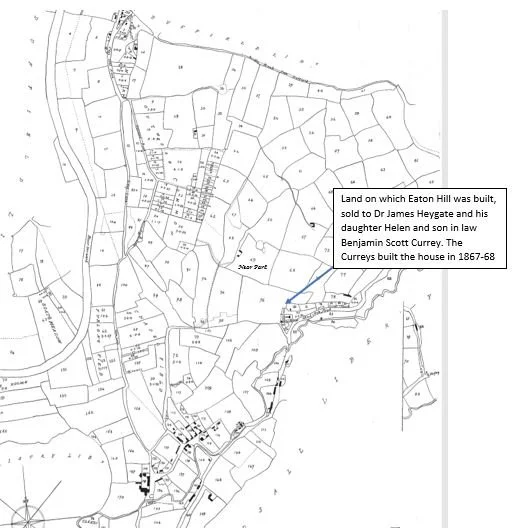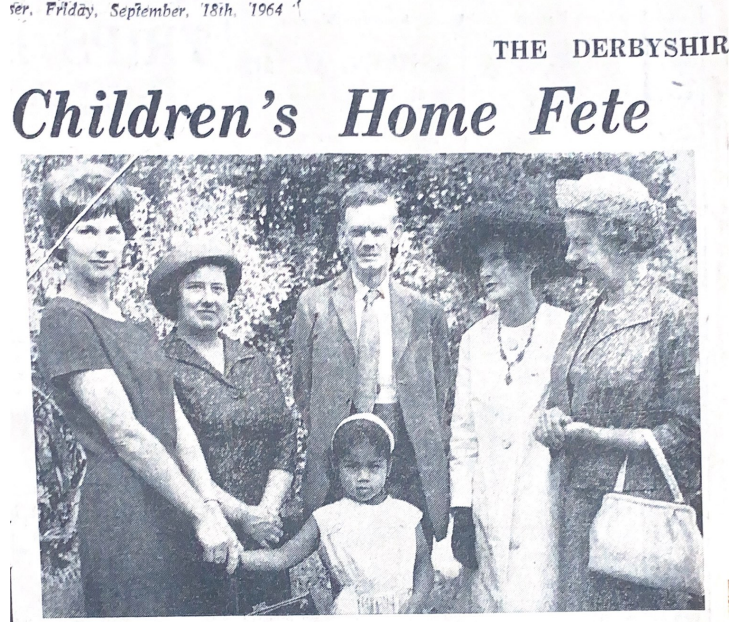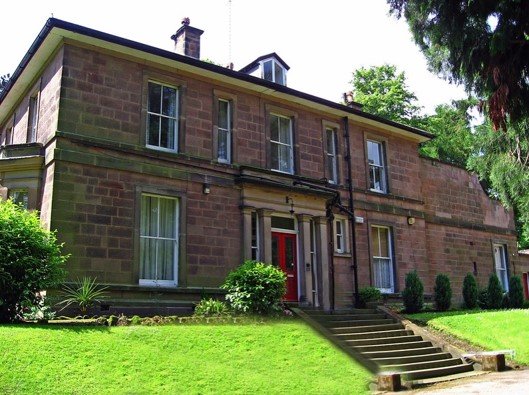
Eaton Hill: Family home and Children’s home
Introduction
Eaton Hill, built on land above the old Alfreton Road, was the family home of the Currey family and became a much loved village children’s home in the 1940s until it closed in the early 2000s. It is now a private house. This article traces the history of the house and stories from the Children’s Home.
Background
For about 50 years the land on which Eaton Hill was built was originally fields let to the Brown family at Park Farm by Dorothy Webster Trowell and later her daughter Elizabeth from Thornhill.
When Elizabeth Trowell died she bequeathed the Copyhold of this land to William Brown and his wife Cecilia who had worked for the Trowells for most of their lives.
In 1865 the Browns sold the Copyhold of the fields and a small farmhouse (about 21 acres) for £2,017. 19s. 5d to a Dr. James Heygate, a wealthy Derby surgeon whose eldest daughter, Helen had married Benjamin Scott Currey. Dr Heygate gave the Copyhold to his daughter and son-in-law.
Later, the Freehold of the land was purchased by Benjamin Scott Currey and Helen Currey from the Ecclesiastical Commission.
Map of Little Eaton late 18th Century
Benjamin Scott Currey 1830-1910
Benjamin Scott Currey was a solicitor in the employ of the 6th Duke of Devonshire as were 3 or 4 of his elder brothers including Henry. Henry was the Duke’s architect. Benjamin and Helen Currey engaged Henry to design and build a new house on the brow of the hill in 1867.
The family, with their four oldest children, moved in about 2 years later. Four more children were born at Eaton Hill.
The Currey family lived at Eaton Hill from 1868 to 1943.
There were always live-in servants: a cook, housemaids and nurses.
In about 1900, about 10 years before Benjamin Scott Currey died, plans were made to convert Eaton Hill into a Children’s Home, but these plans were not realised at that time.
Helen died in 1917, and the house was empty for some time. Much of the furniture and effects of the house were sold off
A Family Trust was established to administer the Estate (now about 25 acres) and lasted until the deaths in 1986 of the last of the trustees: Charlotte Maisie and John Heylyn Currey.
Of Benjamin and Helen’s children, 3 sons became Anglican priests - Reginald, Launcelot and Cecil. They and their 2 sisters never married.
Percy Heylyn Currey had three children, Charlotte (known as Maisie), John and Joyce.
His brother Henry (Harry) became a solicitor and he and his wife Annie lived at “The Poplars” on Station Road and then in Idridgehay before returning to Eaton Hill after his mother died.
Harry and Annie lived at Eaton Hill for over 20 years. The 1939 Register lists Harry and Annie, a cook and 2 housemaids who were twin sisters.
Annie died in 1940 and Harry in 1943.
Eaton Hill becomes a Church of England Children’s Society Home
The plans that had first been proposed in 1899 to convert Eaton Hill into a Children’s Home were only set in motion after Harry’s death. It is not surprising that with all the Anglican Priest members of the Currey Family Trust that it was the Church of England that ran the Children’s Home. Originally called the “Waifs and Strays” society, The Children’s Society that ran the home still exists today.
The Children at the home
Children started arriving at Eaton Hill in 1942. It was wartime and there was a desperate need for homes for babies whose parents had both died or whose mothers were left alone and unable to cope. In 1943, there were already 24 babies, aged between 0 and 2, even before the building was officially designated as a Children’s Home.
From the start, the policy was to create a happy and stable family home for the children. There were attempts to find families keen to adopt children where that was possible, but many of the children stayed at Eaton Hill for many years.
Inevitably, the nature of the care changed as the children grew older. By 1953 there were 13 children aged between 5 and 15.
In 1967, there were 13 aged from pre-school toddlers to older teenagers. A note in the annual report said that “no birthday passed without a party”.
Children outside Eaton Hill Children’s Home in 1963
By the 1980s, the nature of needs changed too. Eaton Hill established a reputation for being able to meet the needs of children with more complex conditions. It adopted the term “Therapeutic Community” to indicate that the aim was not simply to cater for the physical needs of the children but to develop their educational and social horizons and fit them for independent living in their communities.
As a result of the care and support the children received, many of them kept in touch with the home after they had left. Many of them remained in contact with key workers on the staff for decades and there are letters from across the country and abroad from alumni who remembered their time at the Home with affection.
One of the dedicated staff: Anne Lomas
The Staff and Volunteers
The support staff were strongly motivated and caring. In the 1940s, there were 10 nurses, employed to look after babies. As the residents became older, qualified social workers and teachers were employed to educate the children for adult life. The Home developed a good reputation as a suitable place for the training of social workers.
Over the years, the Home was able to employ several talented cooks who were able to provide excellent fresh, locally sourced food for the children.
Eaton Hill was blessed with strong and caring leadership throughout its existence as a Children’s Home. The first “Master” and “Matron” were Mr and Mrs Lomas. They were determined to create a family home and to maintain a supportive and loving environment.
Their daughter, Ann, grew up almost as part of the family and when her mother died in 1962 took over as House Mother/Matron at the age of 23 . Mr Lomas carried on as Master for a couple of years.
In 1964, the leadership passed to Mr and Mrs Seagreave.
They were reported as creating “a relaxed and happy atmosphere to which the children respond with confidence and contentment” In the early 1980s the leadership passed to John Baker who carried on the ethos of care and support, adapting it to meet the challenges of children with more complex needs.
Throughout its existence, Eaton Hill encouraged Volunteers to play their part in its activities. Until the 1970s, this included approved families acting as “aunts” and “uncles” for some of the children, taking them home for weekends or holidays and keeping in touch at Christmas and birthdays. Other volunteers were involved with fund-raising and other activities, particularly with an annual fete which took place every June. Stalls and games were organised on the adjacent field and the village would turn out to join in to support the event. The proceeds were not insubstantial and helped to provide treats for the children and facilities in the building.
The Activities and Events: A Children’s Home becomes a family home
The House Committee always strived to make Eaton Hill into a large family home for the children who lived there. In December 1954, the Secretary of the Committee Norah Haslam summed this up in her annual report:
“Eaton Hill affords opportunities for children who would not otherwise enjoy them to experience the privileges of a home. We endeavour to provide the nearest possible equivalent of a natural Christian family life for every child in our care. Their physical, mental and spiritual wellbeing is carefully nourished, and we ask for the prayers of those who help to sponsor the work here. ”
As soon as the children were old enough, they were enrolled in local schools. This was usually Little Eaton Primary School for the infants and juniors and Denby Secondary modern School for older children. Several children passed their 11 plus exam and went to grammar school and great attention was paid by staff to find suitable places. Some children admitted to the Home needed more personal attention before regular attendance at school and the Coach House building at Eaton Hill was adapted to form a school room for them and for additional tuition for children attending mainstream school.
Little Eaton school in the 1950s. Many children from Eaton Hill attended the school.
The children were taken on holiday every year. Often this was to a residential centre at the coast or in the Peak District. When John Baker was appointed, he insisted on all residents acquiring their own passports, partly to give the children the sense of their own individuality and partly to allow for foreign travel. Thereafter there was an annual trip abroad for a summer holiday.
The Garden Fete was an important annual fundraising event and the whole village got involved.
The Annual Garden Fete
Eaton Hill relied on volunteers and donations and one of the most important events each year was the Garden Fete, held from the 1940s to the late 1970s. A different dignitary opened the fete each year; in 1978, it was the Duchess of Devonshire.
The Friends of Eaton Hill were formed to support the fundraising activities - their efforts and donors were essential to keep the home running.
A different dignitary opened the fete each year.
Holidays
The home also raised funds so that the children could have a family holiday each year. This often involved a trip to the seaside, and the occasional trip to France was added in the 1980s.
Fire at Eaton Hill
The building itself stood up very well to the rigours of life as a Children’s Home. Large open fires heated the rooms and the children all worked to keep the house clean and the grounds maintained.
The committee repaired any damaged using funds raised from the fete and donations. The only serious damage was smoke damage in 1988 when a fire broke out. The staff had to remove the children from the home and found alternative accommodation whilst repairs took place, including using homes of local people or staff.
The fire at Eaton Hill, 1988
Governance
For 40 years, the home was overseen by The Church of England. Originally, it was part of the “Waifs and Strays” Society but this name was soon dropped and became “The Children’s Society”. Throughout this time, the Committee overseeing Eaton Hill took great pride in the fact that it relied solely on charity, taking no money from the State.
The Currey family remained closely involved, Launcelot Currey was Chairman until his death in 1959 and his brother the Rev Cecil Currey was also on the committee.
Percy’s children, John Currey and Charlotte Maisie Currey were also involved. Charlotte was secretary until 1952 and her brother John was on the committee as a Visitor throughout the 1950s. John Currey later became President and remained involved well into the 1980s
Many local people also sat on the Committee, took on various roles and volunteered at the home. These included Barbara Wood, who became Chair in 1963, Norah Haslam, who was secretary for many years in the 1950s and 1960s.
In the late 1960s and 1970s, The Children’s Society started to move away from providing direct care to become one of the largest adoption agencies in the country, providing play groups, youth clubs and short- term accommodation for needy children.
The death of Lancelot Currey was reported in the paper in 1959
The House Committee in the 1950s
By the 1990s, the individual child placements at the Home were funded by Local Authorities, but the Therapeutic Society struggled to get the funds it needed.
National policy for children in care was changing and it became apparent that there was little prospect of continuing Eaton Hill as a children’s home in the long term.
The Church of England Children’s Society closed many of its homes around the country, but the Eaton Hill staff and supporters created a new Charity to continue running Eaton Hill in 1994. The new charity, Eaton Hill Therapeutic Community, fought to keep the home open and raised funds through local appeals.
The Therapeutic Community continued to run the home, supporting children with complex needs, until the financial situation became unsustainable and Eaton Hill was closed in 2003, and the building was sold.
The Therapeutic Community takes over from the Church of England in 1994
The house remained empty for many years and the fabric suffered.
It was bought in 2010 and the new owner was able to restore it, preserving many of the original features.
Parts of the house have been separated to form two new residences but the main rooms remain as they were when they were built as a grand mansion for the Currey family.
Eaton Hill remains part of the character of Little Eaton, and some of the memories below show how important it was to the people that lived and worked there.
Corrections, additions and comments are welcome.
We are very grateful to the many people who contributed memories for the talk and for this article.
Please send any comments or corrections to info@lelhs.org.uk














